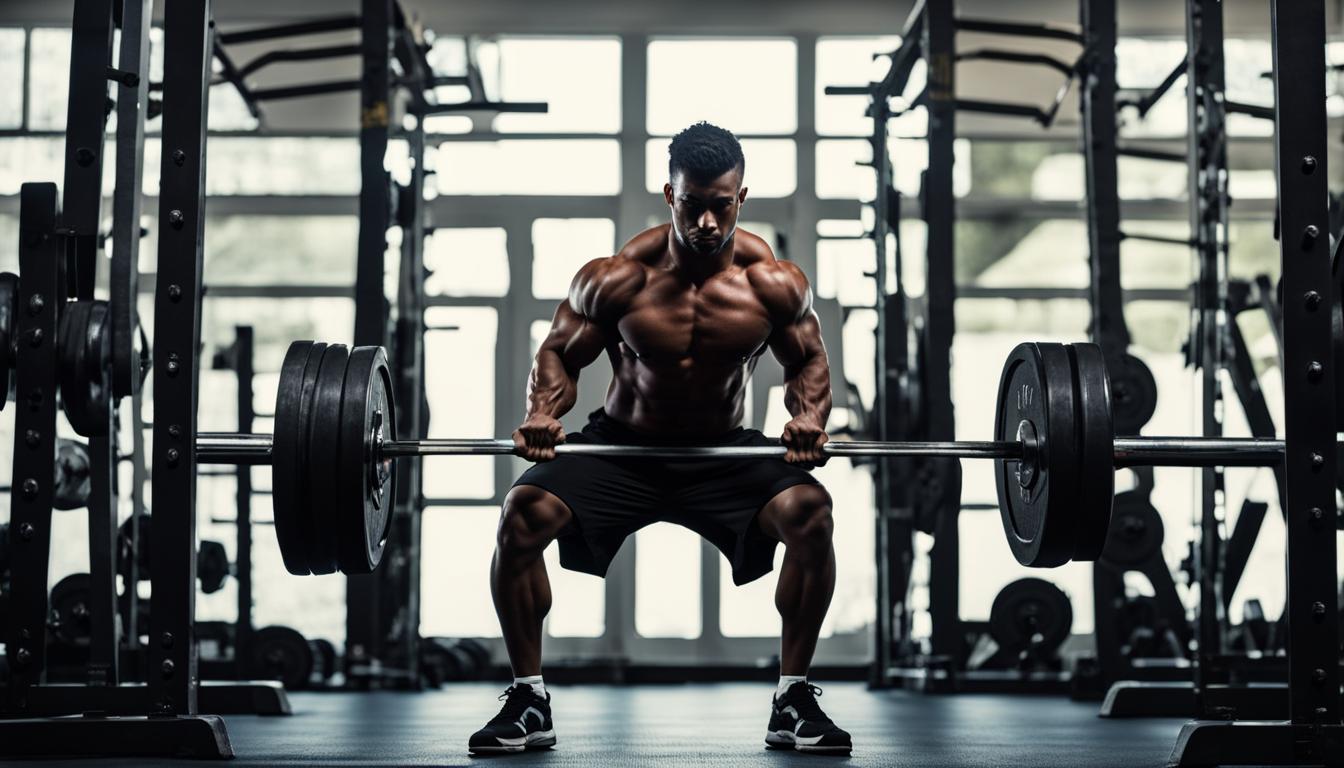Welcome to our comprehensive guide on muscle-building exercises to help you achieve optimal strength gains. Whether you’re a beginner or an experienced fitness enthusiast, incorporating the right exercises into your routine is key to maximizing muscle growth and overall strength.
In this section, we will explore a variety of exercises specifically designed to target different muscle groups and provide a well-rounded workout. By incorporating these exercises into your training regimen, you can take your strength gains to the next level.
Compound Exercises for Muscle Building
Compound exercises are a key component of any muscle-building program. These multi-joint movements engage multiple muscle groups simultaneously, allowing you to maximize your gains in muscle mass and overall strength. By incorporating compound exercises into your routine, you can efficiently target a large number of muscles in a shorter amount of time.
One of the most effective compound exercises is the squat. This exercise primarily targets the quadriceps, hamstrings, and glutes, while also engaging the core and upper body for stability. Squats can be performed with a barbell, dumbbells, or even just your body weight.
Another compound exercise that should be a staple in any muscle-building program is the deadlift. This exercise works the entire posterior chain, including the glutes, hamstrings, and lower back. Deadlifts can be performed with a barbell, dumbbells, or kettlebells, depending on your preference and available equipment.
Bench presses are also highly effective compound exercises for building upper-body strength. This exercise targets the chest, shoulders, and triceps, helping you develop a strong and well-defined upper body. Whether you choose to use a barbell, dumbbells, or resistance bands, bench presses are a fundamental exercise for muscle building.
Pull-ups are an excellent compound exercise for targeting the muscles of the back and arms. By pulling your body weight up towards the bar, you engage the latissimus dorsi, rhomboids, biceps, and forearms. If you find pull-ups challenging, you can use an assisted pull-up machine or resistance bands for added support.
When performing compound exercises, it’s important to maintain proper form and technique to prevent injuries and ensure optimal muscle activation. Start with lighter weights or modifications if you’re new to these exercises, and gradually increase the resistance as you become more comfortable and proficient.
By incorporating compound exercises like squats, deadlifts, bench presses, and pull-ups into your muscle-building routine, you can effectively target multiple muscle groups and accelerate your progress towards achieving your strength and muscle-building goals.
Isolation Exercises for Targeted Muscle Growth
Isolation exercises are a key component of any well-rounded muscle-building program. These exercises specifically target individual muscles or muscle groups, allowing you to focus on areas that may require extra attention for development and growth. Incorporating isolation exercises into your routine can help you achieve targeted muscle growth and enhance overall muscular definition.
When performing isolation exercises, it’s important to maintain proper form and technique to effectively engage the targeted muscles. This ensures maximum muscle activation and minimizes the risk of injury. Here are some popular isolation exercises that can help you isolate and develop specific muscle groups:
Bicep Curls
Bicep curls primarily target the biceps brachii, the muscle on the front of your upper arm. To perform this exercise, hold a dumbbell in each hand with palms facing forward and arms fully extended. Keep your elbows close to your sides and slowly curl the weights up towards your shoulders. Pause briefly at the top and then lower the weights back down with control.
Tricep Extensions
Tricep extensions focus on the triceps brachii, the muscles on the back of your upper arm. You can perform this exercise using a dumbbell or a cable machine. Stand or sit with a weight in one hand and extend your arm overhead. Bend at the elbow and lower the weight behind your head. Extend your arm back up to the starting position and repeat.
Shoulder Raises
Shoulder raises target the deltoid muscles in your shoulders. There are several variations of shoulder raises, including front raises and lateral raises. For front raises, hold a dumbbell in each hand and lift your arms in front of you until they are parallel to the ground. For lateral raises, perform the same movement but lift your arms out to the sides instead.
Leg Extensions
Leg extensions specifically target the quadriceps muscles in the front of your thighs. Sit on a leg extension machine with your legs positioned under the padded lever. Extend your legs until they are straight, pause for a second, and then slowly lower the weight back down.
Remember to adjust the weight and resistance according to your fitness level and gradually increase as you become stronger. It’s also important to include a variety of isolation exercises in your routine to ensure balanced muscle development throughout your body.
Functional Exercises for Total Body Strength
Functional exercises play a vital role in enhancing overall strength and improving performance in everyday activities. These exercises are designed to mimic natural movements and engage multiple muscle groups, resulting in improved coordination, stability, and muscular endurance. When incorporated into your workouts, functional exercises can help you build total body strength and enhance your functional fitness.
One of the most effective functional exercises is the push-up. This compound movement targets your chest, shoulders, triceps, and core muscles, providing a challenging upper body workout. To perform a push-up, start in a high plank position with your hands shoulder-width apart, lower your body towards the ground by bending your elbows, and then push back up.
Another great functional exercise is lunges. Lunges target your quadriceps, hamstrings, glutes, and calves, helping to strengthen your lower body. To perform a lunge, step forward with one leg, keeping your front knee bent at a 90-degree angle and your back knee hovering just above the ground. Alternate legs and repeat for a total of 10-12 repetitions.
Planks are excellent for developing core strength and stability. This static exercise engages your abdominal muscles, lower back, and shoulders. To perform a plank, start in a push-up position and lower your forearms to the ground, ensuring your elbows are directly beneath your shoulders. Hold this position for 30-60 seconds, focusing on keeping your body in a straight line from your head to your heels.
Finally, kettlebell swings are a dynamic exercise that targets your posterior chain, including your glutes, hamstrings, and lower back. To perform a kettlebell swing, stand with your feet shoulder-width apart and hold a kettlebell with both hands between your legs. Keeping your back straight, hinge at the hips, and swing the kettlebell forward and upward, using the momentum to bring it to eye level. Repeat for 10-15 repetitions.

By incorporating functional exercises like push-ups, lunges, planks, and kettlebell swings into your workouts, you can build total body strength and improve your functional fitness. These exercises not only target multiple muscle groups but also help you develop coordination, stability, and muscular endurance, making them a valuable addition to any strength training program.
Training Tips and Considerations for Muscle Building
When it comes to muscle building, there are several key considerations and training tips that can help you optimize your results. Whether you’re a beginner or an experienced lifter, understanding these principles is essential for maximizing your gains.
The Importance of Progressive Overload
In order to stimulate muscle growth, it’s important to progressively overload your muscles over time. This means consistently challenging yourself by increasing the weight, reps, or sets of your exercises. By gradually increasing the demands placed on your muscles, you can promote continuous growth and strength gains.
Proper Nutrition for Muscle Building
Training alone is not enough to build muscle. You also need to provide your body with the necessary nutrients to support muscle growth and repair. Aim to consume a balanced diet that includes an adequate amount of protein, carbohydrates, and healthy fats. Additionally, consider incorporating supplements such as whey protein and creatine to support your muscle-building goals.
The Role of Rest and Recovery
Rest and recovery are just as important as training itself when it comes to muscle building. Your muscles need time to repair and rebuild after intense workouts. Make sure to prioritize quality sleep, as it plays a crucial role in muscle recovery. Additionally, plan regular rest days to avoid overtraining and allow your body to fully recharge.
Consistency is Key
Consistency is the key to success in any training program. Aim to establish a regular workout routine and stick to it. Consistently challenging your muscles and providing your body with the right nutrition and rest will yield the best results over time. Remember, building muscle is a gradual process that requires patience and dedication.
Common Mistakes to Avoid
When it comes to muscle building, there are some common mistakes that can hinder your progress. One of the most common mistakes is focusing too much on isolation exercises and neglecting compound movements. Compound exercises engage multiple muscle groups and are essential for overall muscle development.
Another mistake to avoid is using improper form and technique. Performing exercises with incorrect form can increase the risk of injury and prevent you from effectively targeting the intended muscles. Always prioritize proper form and seek guidance from a qualified fitness professional if needed.
Lastly, avoid neglecting smaller muscle groups. While compound exercises should be the foundation of your training program, it’s important to also include isolation exercises that target specific muscles for balanced development.
By implementing these training tips and considerations into your muscle-building program, you can optimize your results and achieve the strong, sculpted physique you desire.
Equipment and Variations for Muscle-Building Exercises
Besides bodyweight exercises, incorporating different types of equipment and variations into your muscle-building routine can add variety and challenge to your workouts. Not only does this prevent boredom, but it also allows for targeted muscle development and continued progress. In this section, we will explore various equipment options and discuss how to incorporate variations into your muscle-building exercises.
One popular equipment choice for muscle building is dumbbells. They are versatile, accessible, and can be used for a wide range of exercises targeting different muscle groups. Barbells are another effective tool, especially for compound exercises like squats and deadlifts, as they allow you to lift heavier weights and engage multiple muscle groups simultaneously.
Resistance bands are lightweight and portable alternatives that provide constant tension throughout the range of motion, making them ideal for muscle-building exercises. Additionally, machines and cable systems in the gym offer stability and controlled movements, enabling you to isolate specific muscles effectively.
To keep your muscles guessing and progressing, incorporating variations is key. You can modify the angle of an exercise to target different muscle fibers by adding incline or decline movements. Supersets, where you perform two exercises back-to-back without resting, challenge your muscles and keep the intensity high. Another technique is drop sets, where you decrease the weight after reaching muscle failure, allowing for additional repetitions and muscle fatigue.
By incorporating equipment and variations into your muscle-building routine, you can optimize your training and achieve better results. Remember to start with manageable weights and gradually increase the intensity as you progress. The key is to challenge your muscles while maintaining proper form and technique to prevent injuries.
Tracking Progress and Setting Goals
Tracking your progress and setting specific goals are essential components of a successful muscle-building journey. By monitoring your progress, you can effectively evaluate your performance and make necessary adjustments to your fitness routine. There are various methods to track progress, including keeping a workout journal or utilizing smartphone apps designed specifically for fitness tracking. These tools allow you to record your exercises, sets, reps, and weights, providing valuable data that can help you analyze your progress over time.
Setting realistic and achievable goals is equally important for maintaining motivation and ensuring continuous progress in your muscle-building endeavors. When setting goals, it’s crucial to consider both short-term and long-term objectives. Short-term goals can include increasing the weight lifted for specific exercises or completing a certain number of sets and reps. Long-term goals may involve achieving a target body weight or increasing overall muscle mass.
To set effective goals, it’s essential to make them specific, measurable, attainable, relevant, and time-bound (SMART). Specific goals define exactly what you want to accomplish, while measurable goals allow you to track and quantify your progress. Ensure that your goals are attainable and relevant to your fitness level and objectives. Lastly, setting a timeline for achieving your goals helps create a sense of urgency and keeps you focused and motivated.
Remember, progress in muscle building takes time, dedication, and consistency. By tracking your progress and setting realistic goals, you can stay on track, celebrate your achievements, and make adjustments to your training program as needed. So, grab your workout journal or download a fitness tracking app, set your goals, and embark on a rewarding journey towards strength and muscle gains.






